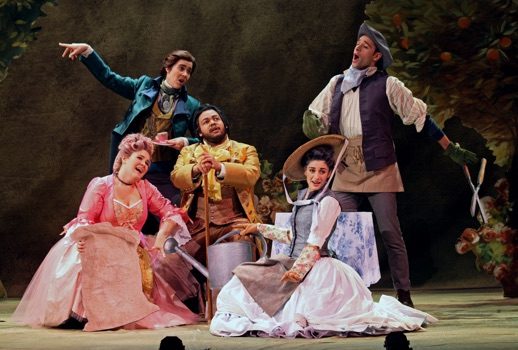

Everything in the garden.
A buddy once remarked that if a conservatory’s doing evening-length Mozart, it’s probably La finta giardinera, an early opus about fakery in a garden. (“Well, that, or I guess maybe like Amadeus or something…?”)
Makes sense. Whatever its flaws, Finta is indeed a wise rep choice for grad students eager to cut their teeth. Premiered in Munich in 1774, the three-act work seems to offer something for everyone: gorgeous lyrical chestnuts as well as flashes of commedia; an aria for each of the leading characters; swift scenic movement from ballads to ensemble finales to mad scenes to baroque court-related satire. No accident that the work has a history of propelling—as Christopher Corwin’s rightly noted—a good number of singers to stardom.
Starting last Wednesday and playing through the weekend at the Peter Jay Sharp Theater, Juilliard is putting its own stamp on the opera, with a generally well sung and visually inventive production that lacks only occasionally in spice.
The story, set largely in a garden, tracks an expansive network of liaisons. Disguises abound. The Marchioness Violante Onesti, still reeling from having been stabbed before the action begins by her bridegroom, the Count Belfiore, has fled with her servant Roberto to work as a gardener named Sandrina for the mayor of a small town.
The ensuing 2.5 hours comprise an extended round of romantic musical chairs. The mayor has his eye on Sandrina. Ramiro, a corny trouser-role cavalier, is in love with the mayor’s headstrong niece, Arminda. Cunning and saucy servants Serpetta and Roberto flirt among the posies, etc.
By the time Belfiore has arrived for a bonus heat of “will they or won’t they” with Sandrina/Violante, we’re all pretty stoked for the parties to settle down with their obvious analogs.
In the program notes, director Mary Birnbaum writes that she and set designer Grace Laubacher opted “to root our production in the relationship of facade to depth”—a choice reflective of the plot’s multiple layers of artifice and intrigue.
Their impulse manifests in several ways, but most ingeniously in the form of two-dimensional pop-up scenery that springs from the ground. Completing the 2D motif, the garden is loaded with droll sight gags—smoke, furniture, animals, even a wheelbarrow, all rendered in cardboard.
Period-appropriate costumes by Amanda Seymour (an associate designer for Madonna’s Rebel Heart tour!) deliver vibrant, splashy colors, rainbow-hued wigs, and cartoonish shapes that flounce nicely to Mozart’s score, here conducted at a breezy pace by maestro Joseph Colaneri with the Juilliard Orchestra.
I did find myself wondering why the visual tone of the opera needed to change so drastically between acts; the light and zany two-dimensionality of the first seemed considerably more Finta-appropriate than the romantic depths of longing evoked by the dark second act in a cave. On Wednesday, these inconsistencies had an odd effect on the opera’s overall pacing, with each subsequent act losing steam as the lighting dimmed.
The cast boasted a number of decorated youngsters, though intriguingly in this production, the standouts were all in secondary roles.
As Roberto, character baritone Jacob Scharfman showed expert command of the Mozartian open style, his “A forza di martelli” aria about hammers proving a particular highlight in the first act. Christine Taylor Price’s Serpetta was memorably comic and impish, and tenor Joshua Blue as the Podestà turned in a well-sung and campy characterization, mincing up his lovelorn mayor.
While all of the romantic leads sang with great polish, their presence onstage had a tendency to wilt. The role of Arminda, for instance, is a study in comic extremity, defiant and full of vinegar, and it should be show-stopping—how I wish Kathryn Henry had loaded the part with the kind of modern, way-way-way-too-far hamminess and edge it merits.
And if Mozart reserved some of the most moving music of his early career for Ramiro and Belfiore, mezzo Marie Engle and tenor Charles Sy seemed to recognize this truth but delivered little else beyond, offering dispassionate performances that may have stemmed from nerves, or lack of imagination, or both? Or, maybe, the tutelage of one Marlena Malas, who apparently coaches them both?
In the title role of the fake gardener the Marchioness, Serbian soprano Tamara Banjesevic sang with gleaming and radiant tone, and earned many of the evening’s shouts of approval from the audience. Where her top occasionally thinned in the flower patch (e.g. a few weak moments in “Geme la tortorella” that her teacher Edith Wiens could have easily fixed in rehearsal), she delivered the necessary fire later on, including a truly impassioned “Crudeli, fermate.”
If Juilliard’s Finta isn’t always outstanding, it does offer the requisite strokes of excellence: an ensemble of budding soon-to-be-somebodies; a florid first act; and Mozart’s perennially inspired music, exuberantly played.
Photo: Hiroyuki Ito

























Comments